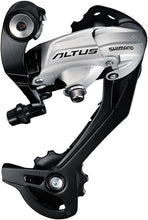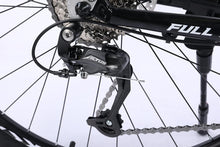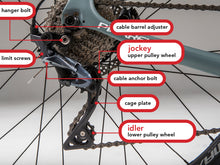
---
**Shimano Altus RD-M370-SGS 9-Speed Rear Derailleur: Precision Engineering for Optimal Shifting Performance**
The Shimano Altus RD-M370-SGS rear derailleur is a high-performance component engineered to deliver seamless and reliable gear shifting in 9-speed drivetrains. This precision-crafted derailleur is designed to meet the demands of avid cyclists seeking top-tier performance for a wide range of riding conditions.
**Technical Specifications:**
1. **Speed Compatibility**: Designed exclusively for 9-speed drivetrains, the RD-M370-SGS is optimized to handle the intricacies of a 9-speed cassette, ensuring precise gear changes under varying loads and terrains.
2. **Long Cage Design (SGS)**: The 'SGS' designation signifies a long cage design, allowing for a wider gear range. This enables the derailleur to accommodate a broader spectrum of cassette sizes, making it ideal for riders tackling diverse landscapes.
3. **Alloy Construction**: The derailleur is constructed from high-quality alloys, providing a perfect balance of strength and weight. This ensures durability while keeping the overall weight of your bike in check.
4. **Direct Mount Compatibility**: The RD-M370-SGS is designed for direct mount applications, facilitating a straightforward installation process. Its compatibility with a wide range of frames and hangers makes it a versatile choice for various bike setups.
5. **Advanced Spring Mechanism**: Featuring a robust spring mechanism, this derailleur maintains consistent tension on the chain, contributing to precise and reliable shifting even in demanding conditions.
6. **Rapid Rise Configuration (Optional)**: Depending on your preference, the RD-M370-SGS is available in both conventional and Rapid Rise configurations. Rapid Rise offers a reverse action to traditional derailleurs, providing a unique shifting experience.
7. **Low-Friction Pivot Bolts**: The derailleur incorporates low-friction pivot bolts, which play a crucial role in reducing resistance during shifts. This feature enhances the overall efficiency of the drivetrain.
8. **Max Chainring Differential**: This derailleur is optimized for a maximum chainring differential of 22 teeth. This ensures compatibility with a wide range of cranksets, allowing for a versatile range of gear ratios.
**Upgrade Your Ride with Shimano Altus RD-M370-SGS 9-Speed Rear Derailleur**
Experience a new level of precision and performance with the Shimano Altus RD-M370-SGS. Whether you're navigating technical trails or cruising through urban landscapes, this derailleur is engineered to optimize your ride.
*Note: Always consult a professional or refer to Shimano's compatibility guidelines to ensure proper integration with your specific bike model and drivetrain components.*

- 11t upper & lower pulleys
- Advanced light-action design
- Teflon-coated bushings
- Direct-attach rear derailleurs


Choosing the Right Bicycle Derailleur: A Comprehensive Guide
Bicycle derailleurs are crucial components that facilitate smooth gear shifting, allowing cyclists to adapt to varying terrains and conditions. Selecting the correct derailleur for your bike is essential for optimal performance and longevity. In this article, we'll delve into the key considerations when choosing a derailleur, including compatibility, gear matching, and brand options.
Compatibility: Shimano vs. SRAM
One of the most critical factors when choosing a derailleur is brand compatibility. Shimano and SRAM, two of the most prominent bicycle component manufacturers, use different derailleur designs and shifting technologies, making them generally incompatible. Attempting to mix these brands can lead to poor shifting performance, potential damage, and safety risks. Therefore, it's crucial to stick with one brand throughout your drivetrain system.
Shimano, Sunrace, and Suntour: Compatible Choices
On the other hand, Shimano, Sunrace, and Suntour derailleurs are generally compatible with one another. This means you have more flexibility in choosing components within this group. You can mix and match derailleurs, shifters, and cassettes from these brands to create a drivetrain that suits your riding style and preferences.
The Importance of Matching Gears
Matching the number of gears between your derailleur, shifter, and cassette is vital for smooth and reliable shifting. For example, if you have an 11-speed cassette, you should use an 11-speed shifter and derailleur. Mismatching gears can lead to poor shifting performance, potential damage to the components, and an overall unsatisfactory riding experience.

Factors to Consider When Choosing a Derailleur
1. Speed Compatibility**: Ensure that the derailleur is compatible with the number of gears on your cassette. Common options include 7, 8, 9, 10, 11, and 12-speed systems.
2. Mounting Type**: There are two main types of derailleurs - braze-on and clamp. Braze-on derailleurs attach directly to a mount on the frame, while clamp-style derailleurs attach around the seat tube using a band clamp.
3. Cage Length: Derailleurs come in short, medium, and long cage lengths. Short cages are suitable for road bikes and provide crisper shifting on flat terrain, while medium and long cages are designed for mountain bikes and accommodate a wider range of gears.
4. Max Cassette Size: Ensure that the derailleur can accommodate the largest cog on your cassette. This is especially important for mountain bikes, as they often have larger cassettes to tackle steep climbs.
5. Brand Compatibility: Stick with a single brand for all your drivetrain components to ensure optimal compatibility and performance.
Selecting the right derailleur for your bicycle is crucial for a smooth and efficient riding experience. Pay close attention to compatibility between brands, make sure the number of gears matches across components, and consider factors like cage length and cassette size. By taking these considerations into account, you can enjoy a reliable and high-performing drivetrain that suits your riding style and needs.


Upgrading your bicycle's derailleur can greatly improve its performance and extend its lifespan. However, it's crucial to do this correctly to ensure compatibility with your existing components. In this guide, we'll walk you through the process of upgrading your bicycle derailleur, covering essential considerations and steps.
Things to Consider Before Upgrading
1. Compatibility**:
- Ensure that the new derailleur is compatible with your bike's drivetrain. Consider factors like speed (e.g., 7-speed, 9-speed, 10-speed) and brand compatibility.
2. Mounting Type:
- Determine if your bike uses a direct mount derailleur or one that attaches to a derailleur hanger. This affects the type of derailleur you need to purchase.
3. Cable Pull Ratio:
- Match the cable pull ratio of the new derailleur with the old one. This ratio dictates how much the derailleur moves for a given amount of cable pull.
4. Cassette and Chain Compatibility:
- Ensure that your new derailleur can handle your cassette's range and that it's compatible with your chain. Different speed cassettes may require specific derailleurs.
5. Derailleur Cage Length:
- Choose the correct cage length based on your cassette size. Short cages are suitable for smaller cassettes, while long cages accommodate larger ones.
6. Tools:
- Gather necessary tools, including Allen wrenches, a cable cutter, a chain tool, and a derailleur hanger alignment tool (if needed).

Step-by-Step Guide
1. Prepare Your Bike:
- Clean the drivetrain and surrounding areas to ensure a smooth installation process.
2. Remove the Old Derailleur:
- Shift the chain onto the smallest chainring and smallest rear cog.
- Use an Allen wrench to remove the derailleur from the derailleur hanger or mount.
3. Install the New Derailleur:
- Attach the new derailleur to the hanger or mount. Ensure it's aligned properly.
4. Adjust the H-Limits:
- Set the high (H) and low (L) limit screws to prevent the chain from falling off. Use the barrel adjuster to fine-tune.
5. Install the Chain:
- If you're replacing the chain, feed it through the derailleur and use a chain tool to connect the ends.
6. Set the Cable Tension:
- Attach the cable to the derailleur, ensuring it's properly seated in the pinch bolt. Pull the cable tight and secure it.
7. Fine-Tune Shifting:
- Shift through all gears to ensure smooth transitions. Adjust the barrel adjuster as needed.
8. Check Derailleur Alignment:
- Use a derailleur hanger alignment tool to verify that the hanger is straight. Misalignment can cause shifting issues.
9. Test Ride and Make Further Adjustments:
- Take your bike for a short ride, testing shifting under load. If necessary, make additional adjustments to achieve optimal performance.
Upgrading your bicycle's derailleur can significantly enhance your riding experience. By considering compatibility, using the right tools, and following these steps, you can ensure a smooth and successful upgrade. Remember to take your time, double-check all connections, and test thoroughly before hitting the road. Enjoy the improved performance of your upgraded derailleur!














